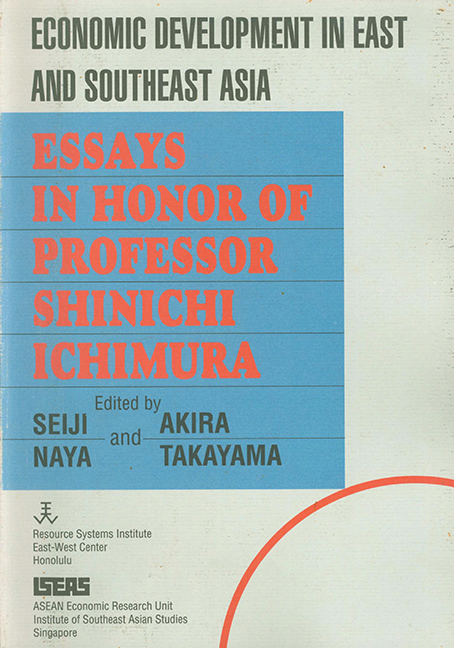Book contents
- Frontmatter
- Preface
- Shinichi Ichimura, 1925-
- CONTENTS
- Introduction
- Contributors to This Volume
- I Structural Change and Economic Development in Developing Asia in the 1990s
- II Explaining the Success of the Four Little Dragons: A Survey
- III Taiwan's Economic Miracle: A Singaporean Perspective
- IV Singapore's Experience of Industrial Restructuring: Lessons for the Other Asian NIEs
- V Korean Industrial Policies for Declining Industries
- VI Vietnam: Recent Economic Developments and the World Economy
- VII Transition from Import Substitution to Export Expansion: The Thai Experience
- VIII Adjustment Problems of a Small Oil-Exporting Country: Did Indonesia Suffer from the Dutch Disease?
- IX A Quarterly Econometric Model of the Hong Kong Economy
- X The Effect ofRicardian Rent Extracting on Macroeconomic Performance
- XI Direct Foreign Investment and the Economic Development of Korea
- XII Japanese Investment in Thailand: Looking Back and Into the Future
- XIII The Effects of Direct Foreign Investment on Taiwan: A Macroeconometric Investigation
- XIV A Reform of the Foward Foreign Exchange Market and Foreign Exchange Rate Determination Policy in Korea, with Foreign Exchange Policy Experiences of Taiwan
- XV Interest Rate and Foreign Exchange Liberalization in Taiwan in the 1980
- XVI Manifold Dilemmas behind External Debt Management
- XVII Agricultural Growth and Food Imports in Developing Countries: A Reexamination
- XVIII The Transformation of Rural Asia and Economic Development Theory and Policy
- XIX The ASEAN Summit and ASEAN Economic Cooperation
- XX The Role of Developing Countries in the New GATT Round
- XXI The Emerging Global Economy and the Role of the Asian NIEs
- Index
IV - Singapore's Experience of Industrial Restructuring: Lessons for the Other Asian NIEs
Published online by Cambridge University Press: 21 October 2015
- Frontmatter
- Preface
- Shinichi Ichimura, 1925-
- CONTENTS
- Introduction
- Contributors to This Volume
- I Structural Change and Economic Development in Developing Asia in the 1990s
- II Explaining the Success of the Four Little Dragons: A Survey
- III Taiwan's Economic Miracle: A Singaporean Perspective
- IV Singapore's Experience of Industrial Restructuring: Lessons for the Other Asian NIEs
- V Korean Industrial Policies for Declining Industries
- VI Vietnam: Recent Economic Developments and the World Economy
- VII Transition from Import Substitution to Export Expansion: The Thai Experience
- VIII Adjustment Problems of a Small Oil-Exporting Country: Did Indonesia Suffer from the Dutch Disease?
- IX A Quarterly Econometric Model of the Hong Kong Economy
- X The Effect ofRicardian Rent Extracting on Macroeconomic Performance
- XI Direct Foreign Investment and the Economic Development of Korea
- XII Japanese Investment in Thailand: Looking Back and Into the Future
- XIII The Effects of Direct Foreign Investment on Taiwan: A Macroeconometric Investigation
- XIV A Reform of the Foward Foreign Exchange Market and Foreign Exchange Rate Determination Policy in Korea, with Foreign Exchange Policy Experiences of Taiwan
- XV Interest Rate and Foreign Exchange Liberalization in Taiwan in the 1980
- XVI Manifold Dilemmas behind External Debt Management
- XVII Agricultural Growth and Food Imports in Developing Countries: A Reexamination
- XVIII The Transformation of Rural Asia and Economic Development Theory and Policy
- XIX The ASEAN Summit and ASEAN Economic Cooperation
- XX The Role of Developing Countries in the New GATT Round
- XXI The Emerging Global Economy and the Role of the Asian NIEs
- Index
Summary
Introduction
Modern economic growth, as emphasized by Simon Kuznets, is always accompanied by structural change. Thus the early phase of modern economic growth in Singapore and in Hong Kong was marked by the rise of the manufacturing sector at the expense of the stagnating or declining entrepȏt trade sector. In Korea and Taiwan, the expansion of the manufacturing sector was marked by the relative decline of agriculture. But structural change is not confined to intersectoral adjustment, it also takes place within the manufacturing sector. Given sufficient institutional flexibility and minimal market distortion, a dynamic economy will carry out structural transformation continuously and concurrently with growth, with new activities rapidly rising to replace old operations and sunrise industries displacing sunset industries. In such a dynamic economy, rapid economic growth facilitates faster structural change, which, in turn, provides new sources for further growth.
Tn 1979, Singapore, after having experienced two decades of high economic growth averaging 8.8 percent for the period 1960-70 and 8.4 percent for the period 1970-79, introduced drastic measures with a view to speed up the process of economic restructuring. The move, which was publicized in Singapore as the “Second Industrial Revolution”, was initially received with some misgivings and skepticism, especially since “high wages policy” was a key policy instrument to spearhead the restructuring. In 1985, as the Singapore economy plunged into a severe recession with negative economic growth, some critics even pointed a finger specifically at the restructuring policy itself for causing the recession.
Today, the Singapore economy has resumed its economic growth momentum. At the same time, it has grown and changed under the impact of the restructuring policy for almost a decade. This is therefore a good time to assess Singapore's industrial restructuring strategies and policies in an objective manner, with a view to drawing some valuable lessons for the other Asian NIEs that are in a similar process of development.
Growth and Structural Transformation
Singapore's successful industrialization drive during the past 25 years is a familiar story. After the present People's Action Party (PAP) government took office in 1959 under the pragmatic leadership of Mr. Lee Kuan Yew, every effort was made to transform Singapore from a country based on entrepȏt trade to one that is based on manufactured exports and tradeable services.
- Type
- Chapter
- Information
- Economic Development in East and Southeast AsiaEssays in Honor of Professor Shinichi Ichimura, pp. 57 - 71Publisher: ISEAS–Yusof Ishak InstitutePrint publication year: 1990



